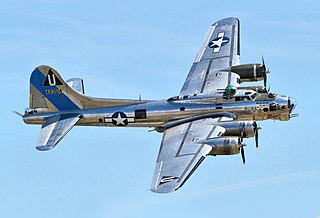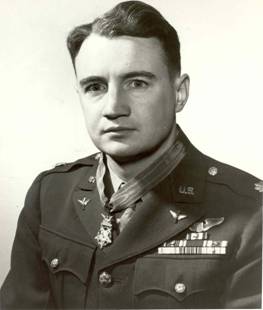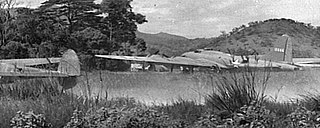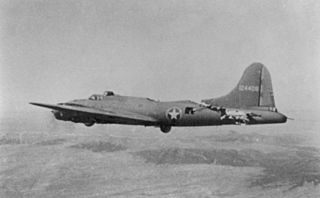Related Research Articles

The Boeing B-17 Flying Fortress is a four-engined heavy bomber developed in the 1930s for the United States Army Air Corps (USAAC). Relatively fast and high-flying for a bomber of its era, the B-17 was used primarily in the European Theater of Operations and dropped more bombs than any other aircraft during World War II. It is the third-most produced bomber of all time, behind the four-engined Consolidated B-24 Liberator and the multirole, twin-engined Junkers Ju 88. It was also employed as a transport, antisubmarine aircraft, drone controller, and search-and-rescue aircraft.

The Vultee A-31 Vengeance was an American dive bomber of World War II, built by Vultee Aircraft. A modified version was designated A-35. The Vengeance was not used operationally by the United States, but was operated as a front-line aircraft by the British Royal Air Force, the Royal Australian Air Force, and the Indian Air Force in Southeast Asia and the Southwest Pacific. The A-31 remained in service with U.S. units until 1945, primarily in a target-tug role.

Royal Air Force Station Polebrook or more simply RAF Polebrook is a former Royal Air Force station located 3.5 miles (5.6 km) east-south-east of Oundle, at Polebrook, Northamptonshire, England. The airfield was built on Rothschild estate land starting in August 1940.

The Schweinfurt–Regensburg mission was a strategic bombing mission during World War II carried out by Boeing B-17 Flying Fortress heavy bombers of the U.S. Army Air Forces on August 17, 1943. The mission was an ambitious plan to cripple the German aircraft industry; it was also known as the "double-strike mission" because it entailed two large forces of bombers attacking separate targets in order to disperse fighter reaction by the Luftwaffe. It was also the first American shuttle mission, in which all or part of a mission landed at a different field and later bombed another target before returning to its base.

The combat box was a tactical formation used by heavy (strategic) bombers of the U.S. Army Air Forces during World War II. The combat box was also referred to as a "staggered formation". Its defensive purpose was in massing the firepower of the bombers' guns, while offensively it concentrated the release of bombs on a target.

The Memphis Belle is a Boeing B-17F Flying Fortress used during the Second World War that inspired the making of two motion pictures: a 1944 documentary film, Memphis Belle: A Story of a Flying Fortress and the 1990 Hollywood feature film, Memphis Belle. It was one of the first United States Army Air Forces B-17 heavy bombers to complete 25 combat missions, after which the aircrew returned with the bomber to the United States to sell war bonds. In 2005 restoration began on the Memphis Belle at the National Museum of the United States Air Force at Wright-Patterson AFB in Dayton, Ohio where, since May 2018, it has been on display. The B-17 used in the 1990 feature film is housed at the National Warplane Museum in Geneseo, New York.

Jay Zeamer Jr. was a pilot of the United States Army Air Forces in the South Pacific during World War II, who received the Medal of Honor for valor during a B-17 Flying Fortress mission on June 16, 1943. After the war, he became an aeronautical engineer and worked in the aerospace industry.

Forrest Lee Vosler, was a Boeing B-17 Flying Fortress radio operator who was the second enlisted U.S. airman to receive the Medal of Honor. He also received the Air Medal and Purple Heart.

The 449th Air Expeditionary Group is a provisional United States Air Force unit assigned to the Third Air Force supporting United States Africa Command. It is stationed at Camp Lemonnier, Djibouti. It flies missions for Africa Command and Combined Joint Task Force – Horn of Africa, supporting varied U.S. objectives in the area.

Old 666 was a Boeing B-17E Flying Fortress heavy bomber, serial number 41-2666, assigned to the United States Army Air Forces (USAAF) 19th and 43rd Bombardment Groups in 1942–1943. It is notable for being the aircraft piloted by Lt. Col. Jay Zeamer Jr. on the 16 June 1943 mission which earned him and 2nd Lt. Joseph Sarnoski each a Medal of Honor, and all other members of the aircrew the Distinguished Service Cross.

The 312th Aeronautical Systems Group is an inactive United States Air Force unit. It was last active in June 2010 at Wright-Patterson Air Force Base, Ohio, where it was a component of Air Force Materiel Command.

The 38th Bombardment Group is an inactive unit of the United States Air Force. It was most recently assigned as the operational (flying) component of the 38th Bombardment Wing, stationed at Laon-Couvron Air Base, France, where it was inactivated on 8 December 1957.

The 303rd Air Expeditionary Group is a provisional United States Air Force unit. In 2011, it was assigned to United States Air Forces Europe to activate or inactivate as needed.

The Charlie Brown and Franz Stigler incident occurred on 20 December 1943, when, after a successful bomb run on Bremen, 2nd Lt. Charles "Charlie" Brown's B-17F Flying Fortress Ye Olde Pub of the United States Army Air Forces (USAAF) was severely damaged by German fighters. Luftwaffe pilot Franz Stigler had the opportunity to shoot down the crippled bomber but did not do so, and instead escorted it over and past German-occupied territory so as to protect it. After an extensive search by Brown, the two pilots met each other 50 years later and developed a friendship that lasted until Stigler's death in March 2008. Brown died only a few months later, in November of the same year.
Brian D. O'Neill is an American author and attorney, best known for Half a Wing, Three Engines and a Prayer, a book about the U.S. Eighth Air Force and B-17 crews and missions in World War II. He is also the author of 303rd Bombardment Group, about the same subject.

Operational Training Units (OTU) and Replacement Training Units (RTU) were training organizations of the United States Army Air Forces during World War II. Unlike the schools of the Army Air Forces Training Command (AAFTC), OTU-RTU units were operational units of the four domestic numbered air forces along with I Troop Carrier Command and Air Transport Command, with the mission of final phase training new pilots or crews. Most were disbanded in the Spring of 1944 and replaced by combat crew replacement centers assigned to base units.

The aircrews of RAF Bomber Command during World War II operated a fleet of bomber aircraft carried strategic bombing operations from September 1939 to May 1945, on behalf of the Allied powers. The crews were men from the United Kingdom, other Commonwealth countries, and occupied Europe, especially Poland, France, Czechoslovakia and Norway, as well as other foreign volunteers. While the majority of Bomber Command personnel were members of the RAF, many belonged to other air forces – especially the Royal Canadian Air Force (RCAF), Royal Australian Air Force (RAAF) and Royal New Zealand Air Force (RNZAF). Under Article XV of the 1939 Air Training Agreement, squadrons belonging officially to the RCAF, RAAF, and RNZAF were formed, equipped and financed by the RAF, for service in Europe. While it was intended that RCAF, RAAF, and RNZAF personnel would serve only with their respective "Article XV squadrons", in practice many were posted to units of the RAF or other air forces. Likewise many RAF personnel served in Article XV squadrons.

Werner George Goering was an American bomber pilot who believed himself to be the nephew of the Luftwaffe leader Hermann Göring. During World War II he flew 48 missions over occupied Europe in Boeing B-17 Flying Fortress bombers.

The All American was a World War II Boeing B-17F Flying Fortress heavy bomber that was able to return safely to its base after having its rear fuselage nearly cut off by an in-flight collision with a German Bf 109 over enemy-held territory. The bomber's flight is said to have yielded one of the most famous photographs of World War II, and has been linked with the phrase "Comin' in on a Wing and a Prayer." It inspired the 414th Bombardment Squadron's emblem, an image of a puppy praying atop an aircraft's tail section.

Everett Ernest Blakely was a career officer of the United States Air Force. He was a highly decorated B-17 pilot with the “Bloody Hundredth” Bombardment Group of the 8th Air Force in Europe during World War II. He received eleven medals for his service including the Silver Star for “gallantry in action”, the Distinguished Flying Cross for “heroism or extraordinary achievement during aerial flight” and the Air Medal with 4 oak leaf clusters. Blakely and the crew of his plane “Just A Snappin” long held the record for the most enemy aircraft shot down on a single mission. The crew of Just A Snappin was credited with 9 enemy aircraft shot down. He also received his Pilot Wings with 3 stars from the Colombian Air Force.
References
- ↑ Noble, Barnes &. "Half a Wing, Three Engines and a Prayer". Barnes & Noble.
- ↑ "Weston Military History Group".
- ↑ "303rd Books and Media". www.303rdbg.com.
- ↑ "World War II History (WWarII.com)".